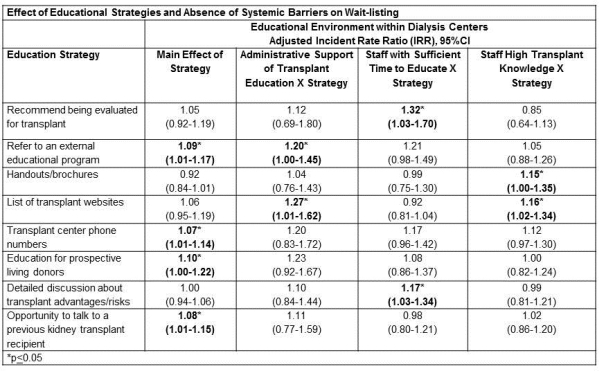Transplant Education Increases Wait-Listing Rates in Dialysis Centers with Supportive Administration and Knowledgeable Staff.
A. Waterman,1 J. Peipert,1 H. Xiao,2 C. Goalby,1 K. Lentine.2
1UCLA, Los Angeles, CA
2St. Louis Univ., St. Louis, MO.
Meeting: 2016 American Transplant Congress
Abstract number: 548
Keywords: Patient education, Psychosocial, Waiting lists
Session Information
Session Name: Concurrent Session: Psychosocial and Treatment Adherence
Session Type: Concurrent Session
Date: Tuesday, June 14, 2016
Session Time: 4:30pm-6:00pm
 Presentation Time: 5:06pm-5:18pm
Presentation Time: 5:06pm-5:18pm
Location: Room 206
While educating dialysis patients about transplant increases its pursuit and receipt, there is variation in educational practices that affects wait-listing rates. There are also dialysis staff- and center-level barriers that reduce the effectiveness of transplant education. We examined the effectiveness of various transplant education practices on increasing dialysis center wait-listing rates in 1,695 U.S. adult, chronic dialysis centers, and determined if the absence of barriers modified the education's effectiveness.
Representatives from centers in all 18 end-stage renal disease (ESRD) networks were surveyed between 2011-2015 about their use of 8 transplant education strategies (Table) and the absence or presence of 3 educational barriers: having insufficient time to educate; an administration unsupportive of providing transplant education; and having low transplant knowledge (assessed via a 12-question measure).
Centers' wait-listing rates for the 12 mo after the survey were calculated using linked United States Renal Data System data. 16,644 patients who initiated dialysis within 6 mo of the survey at participating centers were included. Adjusting for multiple staff and center characteristics, negative binomial regression was used to assess the effect of each education strategy individually on wait-listing rates in a main effects model. Next, we added interaction terms between each educational strategy and the absence of each barrier to determine whether education was more effective in environments without barriers.
Irrespective of center environment, centers that gave out transplant center phone numbers, education for living donors, and offered an opportunity to talk to a transplant recipient had higher wait-listing rates (Table). Wait-listing rates were increased in centers supportive of transplant education.

Multi-level interventions to develop a “pro-transplant” culture in dialysis centers, prepare staff to educate about transplant, and discuss and disseminate transplant education with dialysis patients while also referring externally, can increase the rates of wait-listing nationwide.
CITATION INFORMATION: Waterman A, Peipert J, Xiao H, Goalby C, Lentine K. Transplant Education Increases Wait-Listing Rates in Dialysis Centers with Supportive Administration and Knowledgeable Staff. Am J Transplant. 2016;16 (suppl 3).
To cite this abstract in AMA style:
Waterman A, Peipert J, Xiao H, Goalby C, Lentine K. Transplant Education Increases Wait-Listing Rates in Dialysis Centers with Supportive Administration and Knowledgeable Staff. [abstract]. Am J Transplant. 2016; 16 (suppl 3). https://atcmeetingabstracts.com/abstract/transplant-education-increases-wait-listing-rates-in-dialysis-centers-with-supportive-administration-and-knowledgeable-staff/. Accessed December 22, 2025.« Back to 2016 American Transplant Congress
